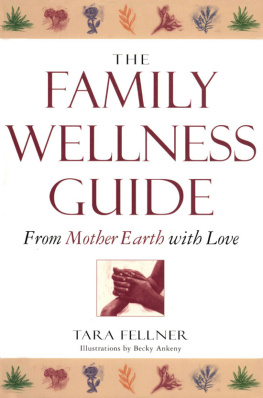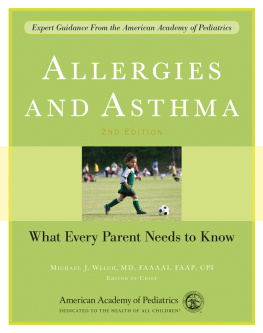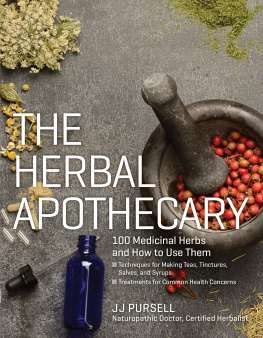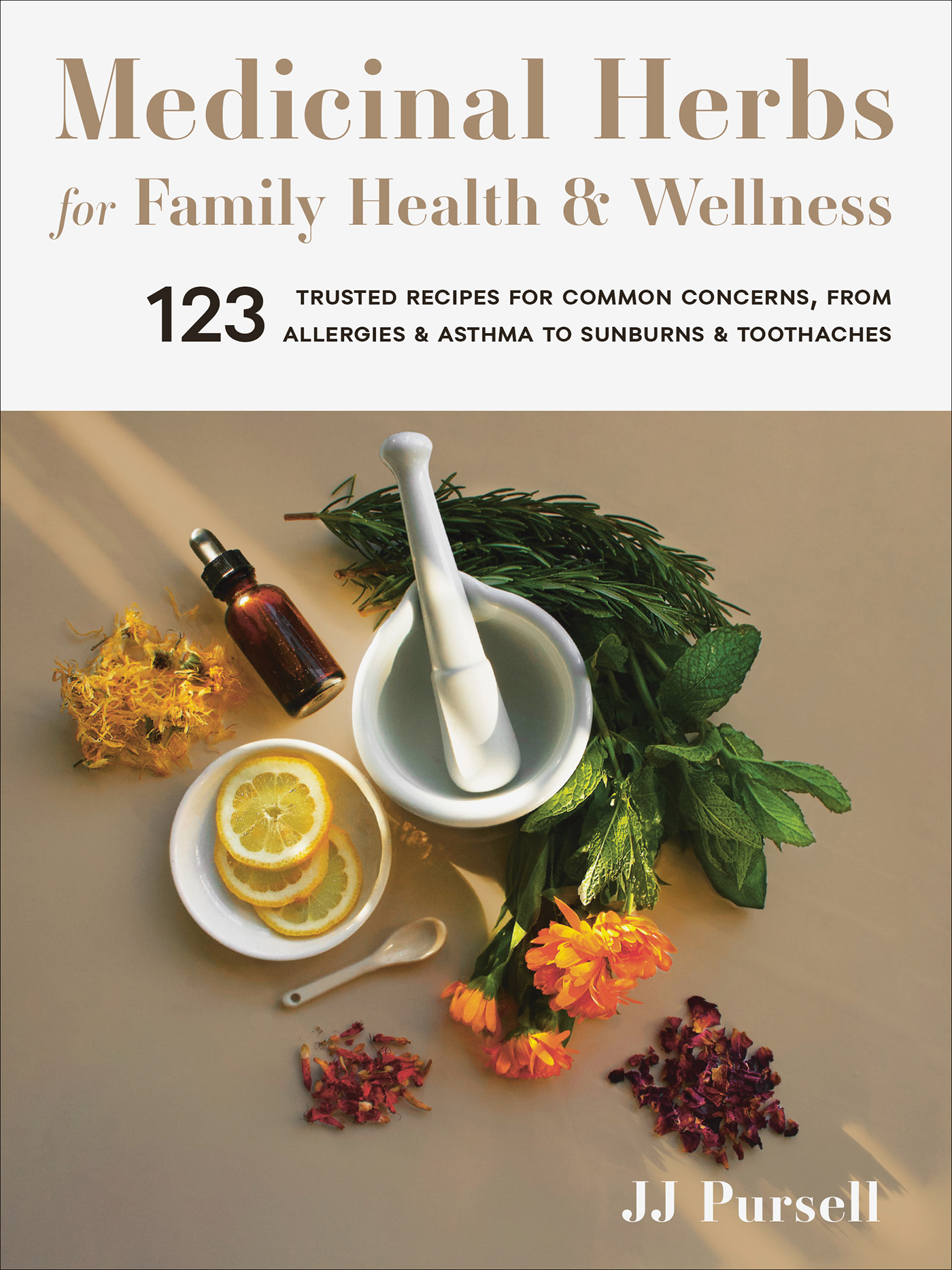Contents
Guide
Page List
Medicinal Herbs
for Family Health & Wellness 123 trusted recipes for common concerns,
from allergies & asthma to sunburns & toothaches JJ Pursell

The information in this book is true and complete to the best of our knowledge. All recommendations are made without guarantee on the part of the author or Timber Press. The author and publisher disclaim any liability in connection with the use of this information. In particular, ingesting wild plants and fungi is inherently risky. Plants can easily be mistaken and individuals vary in their physiological reactions to plants that are touched or consumed. Please do not attempt self-treatment of a medical problem withtout consulting a qualified health practitioner.
Mention of trademark, proprietary product, or vendor does not constitute a guarantee or warranty of the product by the publisher or author and does not imply its approval to the exclusion of other products or vendors. Copyright 2021 by JJ Pursell. All rights reserved.
Photo and illustration credits appear Published in 2021 by Timber Press, Inc.
The Haseltine Building
133 S.W. Second Avenue, Suite 450
Portland, Oregon 97204-3527
timberpress.com Text and cover design by Vincent James eISBN: 9781643260914 Catalog records for this book are available from the Library of Congress and the British Library.
Contents

Introduction
Hello and welcome to the world of herbal medicine. For some of you this may be the very beginning of what I hope is a lifelong journey.
For others it will be another taste of what is already a passion. Either way, youre here and Im glad. As we find ourselves in unprecedented times, with our health at risk at almost every turn, we need to ground ourselves by considering all aspects of medicine and potential opportunities for health. More and more, we are returning to ways of self-reliance and traditional medicine. Herbal medicine is an important tool for helping us live healthier lives and actively participate in improving our overall healthnaturally. You might use herbs as part of a daily routine or maybe you turn to them when something acute shows up at your door.
Studying the plantstheir ethnobotanical and folk uses and the science of the chemical composition that makes them powerful healing agentsgives herbalists and naturopathic physicians like me a framework for prescribing and curating treatments. You may already take herbs, vitamins, and supplements regularly. That market has exploded during the last quarter of a century, encouraging us to take this or that capsule or tablet to regain health and attain vital longevity. The upside to this is that much scientific research and education has been dedicated to natural health products, which has provided consumers with better information regarding what they are taking and what is realistic as far as expected results. The downside is that not everything is what it says it is. Studying the herbs and consulting trusted sources will provide confidence in choosing which herbs to take as well as from whom you should (or should not) purchase herbs and herbal products.
I am dedicated to natural medical practices as a naturopathic physician, licensed acupuncturist, and herbalist, but I want to be clear that I believe there is a time and place for all medical modalities. Without modern science and the American Medical Association model of current medicine, many lives would be lost unnecessarily. As with most things, finding balance is necessary. In my view, all doctors should be teachers, helping their patients learn about their bodies, what is going on inside of them and the ways in which they can treat and heal. Too often, were simply shepherded through an impersonal health care system and given a quick fix without an education about how to avoid the same problem in the future. Or there is not enough information shared regarding how the treatments we are prescribed will affect our physical or mental bodies.
If you arm yourself with the knowledge in this book, youll be able to reclaim some amount of sovereignty over your own health and feel confident about treating yourself for any of the common issues listed here. When we do this, we form a relationship with our body. As our awareness grows of how our body feels when its in balance, we gain keen insight into its form and function, and were better able to identify any imbalances. Many customers came to my herb shop for the first time as new parents seeking gentle but effective ways to help their children move through day-to-day issues and to relieve discomfort. Herbs can offer a supportive approach to many families daily health needs. Encourage your children to share their feelings around how they are feeling in their body when something is off.
Caring for oneself is rarely taught in our culture, but it is necessary. Through conversation with your children and demonstration of your own self-care practice, we can raise a generation of healthier people. Even when they are babies, you can show them the herbs and how to take them. Our kids are always watching us and gain from positive demonstration. I grew up in the 1970s and 80s, and my parents did what they thought was best. As a child of the antibiotic era, I took three or four courses of antibiotics each winter.
Whenever my throat hurt, my ears ached, or my fever shot up, I would be given the same amoxicillin. Sometimes it was warranted, but many times it was not. As I grew older and began studying herbs and nature-cure traditions, I became more comfortable identifying when I was able to treat myself and when I did indeed need to see my health care practitioner. By the time I had my first child, using herbs seemed only natural, and I wanted a different, more balanced approach to healthcare. Children respond so much more quickly than adults to medicines of any type. Just a little yarrow and peppermint tea brought my daughters fevers down, and a little cleavers oil to the throat diminished swollen glands.
When I caught a nasty cold when my son was just four weeks old, I drank a tea of boneset, elderflower, echinacea root, and peppermint to fight it and provide him the protective benefits through my breast milk. I have found that most children relate to plants as healing medicine and often want to know what the herb looks like and how it works. Take advantage of that curiosity and use it as an opportunity to learn together. As with any self-care practice, its important to understand when you need to seek professional help. The recipes in this book are meant to be used for personal health and well-being. They are not meant to cure debilitating illnesses or serious conditions.
While the herbs mentioned in this book are all considered generally safe by the United States Food and Drug Administration, I believe it is always best to consult your practitioner before taking herbs internally to ensure safety and to support your knowledge of herbal medicine. The goal of this book is to provide safe and effective herbal recipes that anyone can use. My wish for the book is that it is relevant and helpful. Ive created a layout that makes it easy to find specific recipes right when you need them. At times, different conditions require different preparationsfor example, for the body surface, sometimes a salve is indicated, other times a poultice, and yet other times a wash. This is the beauty of having choices.






 The information in this book is true and complete to the best of our knowledge. All recommendations are made without guarantee on the part of the author or Timber Press. The author and publisher disclaim any liability in connection with the use of this information. In particular, ingesting wild plants and fungi is inherently risky. Plants can easily be mistaken and individuals vary in their physiological reactions to plants that are touched or consumed. Please do not attempt self-treatment of a medical problem withtout consulting a qualified health practitioner.
The information in this book is true and complete to the best of our knowledge. All recommendations are made without guarantee on the part of the author or Timber Press. The author and publisher disclaim any liability in connection with the use of this information. In particular, ingesting wild plants and fungi is inherently risky. Plants can easily be mistaken and individuals vary in their physiological reactions to plants that are touched or consumed. Please do not attempt self-treatment of a medical problem withtout consulting a qualified health practitioner. 